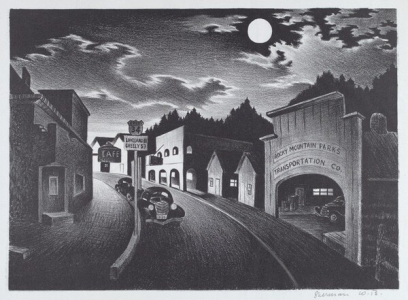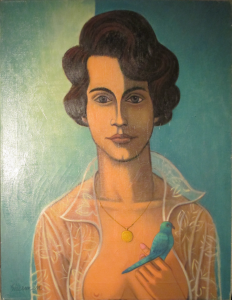Biography
James Russell Sherman was born in Maxwell, IA. Most of his childhood was spent in Sterling, CO, where his father grew wheat. His love for art started at an early age. At 17 he went to New York to join the Art Students League (1923-1931). There he met Thomas Hart Benton, who became a mentor. He also studied with John Steuart Curry, George Picken and Harry Sternberg. From 1927-1931 he attended the Kansas City Art Institute.
Sherman participated in several competitions for Post Office murals. His one successful entry was for Loveland, CO, where his subject was "Industries Around Loveland." To complete this work, he and his wife rented a cottage Estes Park, CO, where Sherman set up his easel out of doors and worked exclusively in the open air. The resulting mural captures the variety of scenes in the Loveland area: wheat fields, row crops, an irrigation channel, a smoke-belching factory, and the glorious mountains in the near distance.
In the late 1930s and early 1940s Sherman's work was exhibited in many venues: the 8th Street Gallery in New York (solo, 1938), the Weyne Gallery in New York (1938), the New York World's Fair (1939), the Art Institute of Chicago (1939-1940), the Denver Art Museum (1940, 1942), the Pennsylvania Academy of the Fine Arts (1942), the Carnegie Institute (1942), the Library of Congress (1943, 1945-1946) and the Philbrook Art Center in Tulsa, OK (1945). He also completed a number of lithographs for the Associated American Artists of New York in the early 1940s and illustrated several books.
When the war came, he joined the 42nd Infantry Division as a military artist, assigned to Camp Gruber in Oklahoma. There he painted murals for the soldiers' children and a mural for the Camp's Social Club. Meanwhile he indulged one of his other passions, serving as art editor for the National Ice Skating Guide (1943, 1944 and 1946-1952). One example of Sherman's work as a military artist shows the loading of bombers in the South Pacific, so at some point Sherman must have transfered out of Camp Gruber into an active war zone.
In 1952 Sherman created paintings on social issues related to highway accidents caused by drunk driving. This campaign spread across a number of states and preceded the similar efforts by MADD by nearly 30 years. Sherman moved to Denver, CO in 1957, where he was able to focus more on ice skating. He became the manager of a rink in downtown Denver where he instructed students in the sport.
Meanwhile Sherman continued to do art, teaching drawing and painting in Denver. He typically spent his summers in Colorado and his winters in New York. He also spent long stretches in Santa Barbara, where he liked to paint the missions, seascapes and local architecture.


Critical Analysis
It's a shame that more of James Russell Sherman's proposed murals were not accepted. His proposal for Marion, Iowa, for example, is an interesting reworking of some of the ideas from his Loveland, CO mural with a touch of Thomas Hart Benton thrown in. The two compositions are remarkably similar: there's a barn and silo to the right of both murals; a water feature to the left in both murals (an irrigation channel for Loveland, but just a trough for Marion); and wheat fields in the center. The Loveland mural has mountains in the background, while the Marion mural has only a small hill. (It's Iowa, after all.) The interesting new element in the proposed Marion mural is the cutaway barn just left of the center of the work. In a style familiar with Benton we see the barn's interior and exterior simultaneously, the cutaway view providing a transition from one perspective to the other. It would have been interesting to see how Sherman might have handled this dramatic element in a full work. The mural that won the Marion commission, "Communication by Mail" by Dan Rhodes, departs entirely from an agricultural theme and shows a dominant railroad engine connecting a postal clerk and a mail patron. It's also a good composition, but in a very different spirit than the Sherman proposal.
Sherman's greatest work lay perhaps in his many lithographs. He was clearly a master of that medium, and he had some commercial success working in it. In addition to his lithographs, murals and paintings, Sherman did watercolors and commercial illustrations. His work was published in Esquire, Fortune, Ladies Home Journal, The New Yorker, Sports Afield and various trade journals.
Beyond the regionalist style of Sherman's work from the 1930s and 1940s, he produced some simple cityscapes, such as his 1956 "Near West New York." Later he ventured into cubism with, for example, "Kay" (1969) and pure abstraction with his "Cityscape" series (1965).
Murals
- Loveland, Colorado - Post Office: Industries Around Loveland
References
- Biography of James Russell Sherman (Artprice).
- Olivia Lowe, Downtown Post Office delivers history, Loveland Reporter-Herald April 23 (2016). Also available here.
- Forest Folk (Mutual Art).
- James Russell Sherman (1906-1989) (David Cook Galleries).
- James Sherman (askART).
- Russell Sherman (Art of the Print).